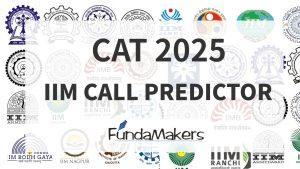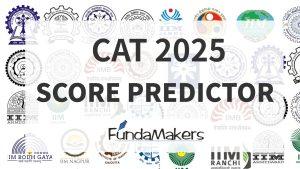Understanding how CAT scores translate into percentiles is crucial for candidates as it allows them to set realistic goals for their performance. The CAT 2024 results are expected to be released in the third week of December, where candidates will find their individual scores and corresponding percentiles. However, prior to the official result announcement, candidates can get a rough idea of their expected CAT score and percentile by looking at the trends from previous years’ data.
What Do You Mean by CAT Score 2024?
There are basically three sections in CAT Exam mainly- Verbal Ability & Reading Comprehension (VARC), Quantitative Ability (QA), Data Interpretation & Logical Reasoning (DILR).
Each of these three sections consists of following marking scheme:
- +3 Points for each correct answer
- -1 for each wrong answer
- No penalty for unanswered question
What Do You Mean by CAT Percentile 2024?
The CAT 2024 percentile is a crucial measure that reflects a candidate’s relative performance in comparison to others who appeared for the exam. It represents the percentage of candidates who scored less than or equal to a particular candidate’s score. For instance, if a candidate secures a 99 percentile, it means they outperformed 99% of the total test-takers in that exam session. This percentile system plays a significant role in evaluating a candidate’s standing, as it helps to contextualize their individual score within the larger group of candidates. Unlike absolute scores, which may vary in difficulty across years, percentiles offer a standardized way to assess performance and rank candidates based on their relative success in the exam. Therefore, understanding CAT percentiles is essential for setting realistic targets and determining one’s competitiveness for admission to top MBA institutes.
How to Calculate CAT 2024 Percentile?
Below is an overview of the expected score vs percentile distribution for CAT 2024. Understanding how percentiles are calculated can help you set a realistic target score. In the CAT exam, your percentile reflects your relative performance compared to other test-takers.
It is calculated based on the formula:

Where:
- N is the total number of candidates who appeared for the exam.
- Rank is your position relative to other candidates, based on the score you achieve.
This means that if you have a higher score compared to most candidates, you’ll have a higher percentile. In general, the more competitive the exam, the more crucial it becomes to aim for a higher score to secure your desired percentile. By understanding this distribution, you can strategize and aim for a score that places you in the percentile bracket you are targeting.
Questions Attempts You Need for 90+ Percentile in CAT 2024
Achieving a 90+ percentile in the CAT 2024 exam is a significant milestone for candidates aiming to secure admission into top-tier MBA institutes. One of the key factors in reaching this goal is understanding the number of questions to attempt in each section, as it plays a crucial role in determining the overall score and percentile. While the exact number of attempts may vary depending on the difficulty level of the exam and individual strengths, having a general idea of the target number of correct attempts can help you strategize effectively. To assist you further, we’ve provided a detailed table below outlining the approximate score needed to secure a 90+ percentile in CAT 2024. Be sure to go through the table to get a clearer picture of how many questions you need to attempt and the corresponding score required to achieve your desired percentile.

CAT 2024 Section-Wise Expected Score vs Percentile
The CAT exam is known for its varying levels of difficulty each year. This means that the score required to achieve a particular percentile can change depending on whether the exam is deemed easy, moderate, or difficult. Below is a table that aspirants can refer to in order to estimate the score they might need to achieve a particular percentile in CAT 2024 based on the exam’s difficulty level:
Slot 1
Here is an overview of the anticipated score vs percentile distribution for CAT 2024 Slot 1:

Slot 2
Here is an overview of the anticipated score vs percentile distribution for CAT 2024 Slot 2:

Slot 3
Here is an overview of the anticipated score vs percentile distribution for CAT 2024 Slot 3:

CAT Composite Score
The CAT composite score is a comprehensive measure of your overall performance in the Common Admission Test (CAT), which is used by various Indian Institutes of Management (IIMs) and other business schools for their admission process. Unlike your raw score (which is simply the number of correct answers you have), the composite score is designed to reflect your relative performance across multiple sections of the exam, adjusting for factors like the difficulty level and the overall performance of the test-takers in that particular year.
How to Calculate CAT Composite Score?

Key Elements of CAT Composite Score Calculation
The CAT composite score is a comprehensive measure used by the IIMs and other B-schools to evaluate candidates for admission. It takes into account various components that reflect not just your performance in the CAT exam but also other factors like academic background, work experience, and diversity. While the specific weightage assigned to each component can vary across different IIMs, the main components of the composite score calculation generally include the following:
- Scaled CAT Score: The scaled CAT score is one of the most important factors in the composite score calculation. It is based on your raw score in the exam, which is then normalized to account for variations in difficulty across different test slots. This normalization process ensures fairness for all candidates, irrespective of whether they appeared for the exam in an easier or more difficult session. The scaled score is crucial for shortlisting candidates, as it reflects your relative performance against all other test-takers in a given year.
- Academic Performance: Your academic history plays an important role in the composite score, as it gives the admissions committee insight into your consistency and academic abilities. This includes:
- Class 10 Marks: Your performance in school is taken into account, particularly your overall grade point average (GPA).
- Class 12 Marks: Similar to Class 10, your marks in high school are considered as an indicator of your academic consistency.
- Graduation Score: The marks obtained during your undergraduate studies are also included. Some IIMs may assign more weight to your graduation score, particularly if you are from a non-engineering background or have a relevant academic background.
- Work Experience: Relevant work experience is another significant factor that can enhance your composite score. It demonstrates your professional experience, which can be valuable in a business school setting. The duration and nature of your work experience matter—relevant experience in fields such as management, finance, marketing, or operations often adds more value. IIMs may give additional points for candidates with substantial professional experience, as it can enrich classroom discussions and provide practical insights.
- Diversity Factors: In line with their goal of fostering a well-rounded, diverse student body, the IIMs factor in diversity in their composite score calculation:
- Gender Diversity: This factor ensures balanced gender representation in the batch, rewarding candidates from underrepresented genders.
- Academic Diversity: This refers to candidates from different academic backgrounds, such as humanities, commerce, or science, compared to the predominantly engineering background of many applicants. Having students from a variety of disciplines is seen as beneficial for creating a dynamic and inclusive learning environment.
Additional Considerations:
The weightage assigned to each of these components can vary depending on the IIM or other B-schools, and some institutes may place more emphasis on certain factors (such as work experience or academic performance). However, the scaled CAT score typically holds the most weight, followed by factors like work experience and academic performance.
Additionally, shortlisting criteria for different rounds—such as Group Discussion (GD), Personal Interview (PI), and Written Ability Test (WAT)—may also factor in a candidate’s composite score. It’s important for candidates to perform well across all areas, as a high score in the CAT alone may not be enough to secure admission if other components of the composite score are weaker.
Where to Prepare for GDPI-WAT?
For CAT 2024 aspirants aiming to ace the GDPI-WAT (Group Discussion, Personal Interview, and Written Ability Test) process, joining FundaMakers can provide a significant advantage. FundaMakers offers expert-guided sessions designed to help candidates navigate the challenging post-CAT selection rounds with confidence. Their specialized training focuses on enhancing communication skills, boosting self-presentation, and sharpening critical thinking, all of which are crucial for excelling in GDs and interviews. Additionally, FundaMakers provides personalized mock interviews and WAT preparation to simulate real-world scenarios, helping you refine your responses and writing skills under timed conditions. With a team of experienced mentors and a structured approach, FundaMakers equips candidates with the tools and strategies needed to perform at their best and secure a place at top IIMs and business schools.



